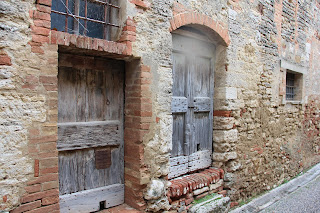On one of our early days in this area we drove a rain-glistening gravel track up to a medieval village on a hill that truly enchanted us. Lucignano d’Asso. It looked, even then, as it likely did in the Middle Ages, with its few tiny pedestrian lanes, climbing ever upwards, tucked between overhanging buildings. Way before that, in Roman times, it was known as Lucignanum Longassum. The village has had a long, long life.
One person, at least, still lives here. He is living inside a ruined building but carts all the equipment he needs up or downhill as he struggles with its renovation, turning his wreck into a dwelling. Much of the old village still belongs to the ancient noble Piccolomini family who have owned it since the 15th century. I wonder how often they visit. One of Saint Bernardo’s hermit friends was a Piccolomini. A couple of other of that family became Popes. The family features large in Italy’s history. They were big movers and shakers in the Guelph movement: those who supported the Papacy; versus the Ghibellines, who didn't: they supported the Emperor. The Piccolomini's likely have many palazzos in many places and there in this quiet place, but magic, to draw them back.
We wandered agog under crumbling arches, then up and down sloping paths, as if we were visiting an ancient movie set. There was even a fascinating barn left wide to the weather that held an old vehicle that, too, might have come from central props: we certainly have no idea what it ever might have been used for. But it suited this atmosphere of this magical village.
That same day further on we were attempting to get into the Truffle Museum in San Giovanni D’Asso, a small town close by, when we came across the young, charming Deputy Mayor who gave us a delightful tour of his council chambers before offering us the key to the museum so we might explore it ourselves. Now, I wish we had taken that option.
He suddenly remembered there was to be a Truffle Sagra, or Festival, in town on Sunday; so instead, invited us to that, so we might go truffle hunting, then truffle tasting, then truffle feasting, then we might finish our day, he suggested, with a visit to the Truffle Museum, which would certainly be open then.
But, that Sunday, we first paid a visit to the Abbazia di Monte Oliveto Maggiore to hear the monks intone the Gregorian Chants. And when we came out into the Abbey grounds the north wind was blowing ice chips our way so we assumed the truffle leader, the trifolau, would call the truffle hunt, the cerca, off that bitter day.
Though, he may not have, for as is the way in this strange land, no sooner had we left the Abbaye and headed back to a toasty fire the weather changed: the sun came out, the wind died down, and the temperature climbed again.
But, too late to turn back.
We have no idea if the festival took place or not, but we do know that there are still truffles out there under the Tuscan tree roots, as another truffle cerca and tasting is to be held this Sunday for interested folk. We, sadly, will be long gone and will miss it. And we have missed the museum as well; as, for some reason, it is only open on Sundays this week and last.
And we will have missed the tasting of the first truffles of the year, the Marzuolo, ready now in March.
And we will miss the black truffle in early June and the prized white diamond, the white truffle, that the dogs will start to snuffle up in September.
But always, I will remember the delicious truffles I have eaten here these last two weeks. A taste treasure in my memory chest that I likely will never repeat.
I will ever remember, too, the amazing wooden doors that lead into the Palazzo from the village square that now holds the council chambers and administrative offices here in town.
These bear the strain of their old age. And the weight of their owners’ perfidy.
One owner in 1151, Count Paltonieri di Forteguerra, pawned this great palazzo to the city of Sienna during a time he was doing it tough. Sounds like those Regency bucks who regularly gave away their ancestral piles, their country castles, in a quick hand of cards at their buck’s club in London, back in the day.
And the lovely square in front of the piazza, decorated in sculpted pieces by an artist-sculptor of the modern school. I do hope his beautiful textured pieces live as long a life as the lovely wooden palazzo doors.
 |
| The track to the Medieval village of Lucignano d’Asso |
 |
| Lucignano d’Asso has had a long long life |
 |
| One man, at least, lives here - doing renovations |
 |
| The ancient noble Piccolomini family have owned the village since the 15th century |
 |
| Ancient vehicle in a barn that looked straight out of a movie seen |
 |
| Entrance to the Council Chambers and Truffle Museum |
 |
| Truffles on display |
 |
| Sculptured pieces decorating the square |
 |
| Wooden doors of the Palazzo that was once pawned for lack of funds |









No comments:
Post a Comment